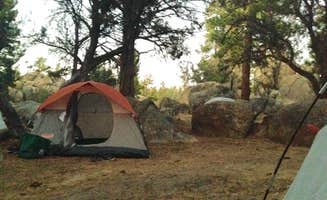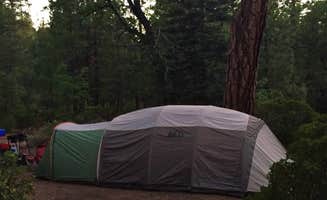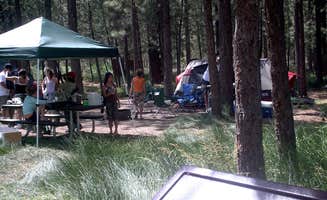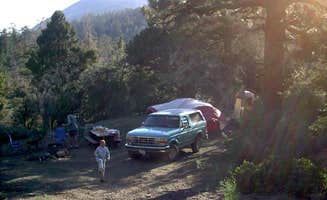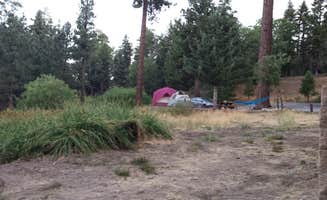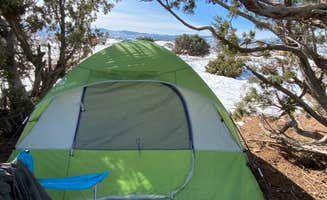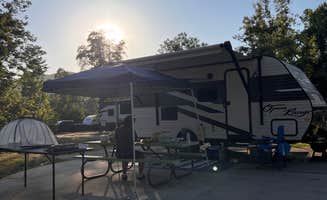Tent camping near Fawnskin, California offers backcountry experiences at elevations between 6,700-7,800 feet in the San Bernardino National Forest. Summer temperatures typically range from 45-85°F with significant cooling at night, even during July and August. Most dispersed sites around Fawnskin lack cell service, with spotty coverage limited to higher ridges and peaks.
What to do
Explore historic mining sites: In Holcomb Valley Climbers Camp, you can combine camping with gold rush history. "If you're into panning for gold you just might find some along Holcomb Creek. There are active claims in the area so be respectful," notes Edward W. The area sits on former mining grounds from the 1800s.
Rock climbing access: Primitive camping puts you near world-class climbing routes. "This area is used almost exclusively by rock climbers, but anyone is welcomed. As long as you follow the guidelines for the area, you can set up your tent anywhere you see a spot," reports Les R. about Holcomb Valley. Routes range from beginner to advanced with most concentrated within 1-2 miles of camping areas.
Connect to Pacific Crest Trail: Backcountry campers at Tanglewood Group Campground can access the famous long-distance hiking path. "It was interesting to learn that Pacific Crest Trail passed through this campground," shares Mon M. The elevation here exceeds 7,000 feet, providing cooler temperatures in summer months.
What campers like
Complete privacy: The Thomas Hunting Grounds Yellow Post Sites offer isolation rarely found elsewhere. "I almost want to give this a 1 star review, just to keep it to myself a little longer. We loved this yellow post site, by far one of my favorites. Private but with cell service, tables and fire pits!" remarks Chelsea R. Sites are spaced approximately 0.25-0.5 miles apart.
Night sky viewing: Campers consistently mention stellar astronomy opportunities. "Not a single sound far from everybody, off the grid," notes Seth B. about his Holcomb Valley experience. The lack of light pollution at these higher-elevation sites creates prime conditions for stargazing, especially during summer new moons.
Wildlife encounters: Forest camping provides animal observation opportunities. "If you're looking for a quiet, more remote campsite while hiking the Idyllwild area then look no further. These 'yellow post' sites are essentially boondocking in the forest off dirt fire service roads," explains Mark C. about Thomas Hunting Grounds. Dawn and dusk offer the best wildlife viewing times.
What you should know
Vehicle requirements: Most dispersed camping requires appropriate transportation. "Need high clearance or 4wd vehicle for a rough road but once you get to the top, the sites are great!" Steve advises about Thomas Hunting Grounds. The final 2-5 miles to most yellow post sites involve unpaved, sometimes rutted roads.
Fire restrictions: Regulations change seasonally and require planning. "There is a fire ring but fire restrictions were in place during our visit," explains Mon M. about Keller Peak Yellow Post Campsites. Rangers actively enforce these rules, especially during summer and fall.
Reservation systems: Some sites require advance planning while others operate first-come-first-served. "This is yellow post camping so it's hit or miss if you can get one. Do your homework and learn what you need to know ahead of time - esp regarding fires," suggests Kate W. about Keller Peak. Yellow post sites typically fill by Friday noon during summer months.
Tips for camping with families
Look for established facilities: Yucaipa Regional Park provides family-friendly amenities. "Great tent camping facilities, privacy from neighbors, access to Zanja Peak Trail head, 3 lakes for fishing, water park during the summer, and friendly helpful staff," reports Bryan H. The water park operates Memorial Day through Labor Day.
Weather preparation: Mountain temperatures fluctuate dramatically. "We stayed in group campsite A. Tent camping is only allowed in group sites. They do have about 30 to 40 RV sites as well. The tent camping sites come with plenty of space for group camping," explains Mary F. about Yucaipa Regional Park. Pack extra layers as temperatures can drop 30°F after sunset.
Plan for limited services: Most sites require self-sufficiency. "Site has pit toilets and picnic tables. There is a fire ring but fire restrictions were in place during our visit. There are not many amenities, but it is a good site for private gatherings or large family camping," notes Mon M. about Tanglewood Group Camp. Bring at least 1 gallon of water per person per day.
Tips from RVers
Access challenges: Mill Creek Dispersed Camping has limitations for larger vehicles. "The road up to the actual spot is gravel, with lots of potholes and washboard areas, which would make it difficult for an RV. But the biggest issue for RVs is an area of the road that is very steep and immediately turns into a hairpin turn," warns Francisco F. Most roads into dispersed sites have 30-45% grades in sections.
Site selection strategy: Arrive with backup options. "There are lots of sites on this road. The closer you are to the road the more dust will get in your site from the vehicles passing," advises Dee M. about Mill Creek. The most level sites typically fill first, often by Thursday afternoon during peak season.
Services trade-off: More privacy means fewer amenities. "Smaller rigs, medium clearance and lite off-road capabilities recommended. Good cellular reception in my particular location," reports Dickie Simmons about Mill Creek. Most sites lack hookups but offer more space between neighbors than established campgrounds.


